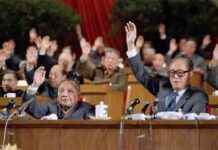China’s Growing Power and Implications for the U.S.
Since the end of the Cold War, the United States has been grappling with the rise of China as a global power. While there have been periods of concern about the sustainability of China’s growth and its political model, it is undeniable that China has emerged as a formidable player on the world stage. With the world’s second-largest economy, extensive global trade partnerships, and a growing military presence, China’s influence is undeniable.
The Impressive Rise of China
China’s economic growth has been nothing short of remarkable. From a GDP of under $397 billion in 1990 to nearly $14.9 trillion in 2020, China’s economic expansion has been exponential. It has become the largest trading partner for over 120 countries and plays a dominant role in global supply chains for critical minerals. Additionally, China’s military capabilities have advanced to the point where experts question the outcome of a potential conflict with the United States over Taiwan.
Furthermore, China has been actively engaging in diplomatic efforts, such as brokering deals between Iran and Saudi Arabia and expanding its influence through the BRICS grouping. This demonstrates China’s ambition to assert itself as a major player in international affairs.
Challenges and Headwinds Facing China
Despite China’s impressive achievements, there are growing concerns about the sustainability of its growth trajectory. Richard Fontaine, CEO of the Center for a New American Security, points out that there is a shift in focus from the unstoppable rise of Chinese power to concerns about the potential decline of China’s economy and population.
China’s economic challenges, including mounting debt, demographic constraints, and geopolitical tensions, raise questions about the country’s long-term prospects. The Belt and Road Initiative, a flagship project aimed at enhancing connectivity and infrastructure development, has faced financial difficulties and geopolitical pushback, prompting China to reassess its strategy for the future.
Evaluating China’s Economic Outlook
While some predict a slowdown in China’s economic growth, it is essential to consider the broader context. The International Monetary Fund forecasts a moderate growth rate for China in the coming years, which, while lower than previous levels, remains robust compared to other advanced economies. Additionally, China still has untapped potential in critical and emerging technologies, providing opportunities for further growth.
Moreover, China’s demographic challenges, such as an aging population and shrinking workforce, are not unique to the country. Many other nations, including core U.S. allies and partners, face similar demographic trends. Therefore, it is crucial to assess China’s economic prospects in a comparative context.
Navigating U.S.-China Relations
The evolving dynamics between the United States and China present complex challenges for policymakers. The narrative of strategic competition between the two nations is deeply ingrained, fueling anxiety and defensive postures on both sides. However, there is a need to adopt a more nuanced approach to managing the U.S.-China relationship over the long term.
National Security Advisor Jake Sullivan emphasizes the importance of coexisting with China as major powers on the global stage. Rather than seeking a decisive victory in the strategic competition, both countries must learn to navigate their differences and find ways to coexist peacefully. This requires a strategic renewal within the United States, strengthening internal foundations of strength and fostering enduring alliances and partnerships.
Looking Ahead: Future Scenarios and Considerations
As the debate over China’s rise continues, it is essential to consider multiple scenarios and factors that will shape the future trajectory of U.S.-China relations. From economic challenges to geopolitical tensions, there are numerous variables at play that will influence the dynamics between the two nations.
China’s deepening ties with Russia and Iran, as well as its engagement with hedging powers and developing countries, highlight the complexity of its global strategy. The CCP’s vision for a “great rejuvenation” and the initiatives it has launched demonstrate its aspirations for greater influence on the world stage.
Ultimately, the United States must adopt a forward-looking approach to competing with China, one that values strategic partnerships, internal resilience, and a long-term perspective on managing the complexities of a multi-polar world. By acknowledging the strengths and weaknesses of both nations, policymakers can chart a course for constructive engagement and peaceful coexistence in an increasingly interconnected global landscape.

















